

How to Write a Case Study in Research? (with Examples)

A case study is a powerful tool in research and education, offering deep insights into complex phenomena through the lens of a single subject or group. Case studies zoom in to the details of a specific situation, examining context, history, and behavior to reveal certain patterns and highlight practical applications of theories.
A case study in research can be used when:
- atypical or abnormal behavior or development is observed,
- an unexplained outcome to treatment is found, or
- an emerging disease or condition occurs.
Thus, case studies enable researchers and practitioners to analyze specific instances, identify trends, and obtain learnings that can inform broader decision-making and problem-solving. In this post, you will learn all about case studies, including how to conduct a case study , limitations and benefits of a case study , and case study methods .
What is a Case Study ?
Case study definition : A case study is an in-depth or intensive study of a person, group, or event. Case studies involve deep analyses of an individual or group to identify patterns and are used across fields such as psychology and medicine to draw broad conclusions. They are descriptive studies based on qualitative data such as observations, interviews, questionnaires, clinical notes.
Here are some historically significant case study examples:
The curious case of Phineas Gage: This is arguably the most cited case study in psychology, which sheds light on how different areas of the brain affect personality and cognition. While working as a construction foreman on a railroad, Phineas Gage was involved in an accident in which a rod impaled his brain. Gage survived the physical trauma, but his personality and his ability to learn new skills were altered. This case report was crucial to research on brain function, memory, and personality.
Anna O and the talking cure : Anna O (pseudonym) was a German woman who was one of the first patients to undergo psychoanalysis. Her case inspired many of the theories of Freud and other prominent psychologists of the time to mitigate the symptoms of depression through “talk therapy.” This case study is still cited as a reason psychologists believe that psychotherapy, or talk therapy, can be helpful to many patients.
When to Do a Case Study ?
The case study design may be chosen by a researcher in the following situations:
Need for deep understanding: When you require detailed insights about a specific situation, and you want to understand complex relationships and processes.
Resource constraints: When you have limited time and finances available for research and/or limited access to large sample sizes.
Research context: Certain real-world phenomena need to be studied in their natural context, especially when you cannot control variables.
Accordingly, the types of research questions best suited for a case study are exploratory (e.g., when investigating a new or poorly understood phenomenon, emerging conditions, adverse reactions to treatments, new methods of treatment) or involve unique situations (e.g., rare or exceptional cases, atypical behavior, breakthrough events). See Table 1 for developing a case study from a research question.
The case study design might be for a single case study, such as for unique cases or when studying a representative or typical case, or multiple case studies (a case series, comparative analysis, or to identify patterns across different contexts). Note that a case study is not recommended if you require statistical generalization or broad population-level insights.

How Long Should a Case Study Be?
Case studies are structured very differently from research articles (see “ How to write a case study in Research ” below and the case study template in Figure 1). However, as a general guideline, note that case studies might range from 500 to 1,500 words. The word count would depend on factors such as the target journal’s specifications, case type, and study discipline. Case reports also have a limit on the number of references to be cited. Remember, you must always check the target journal for word and reference limits before submission.
How to Write a Case Study in Research
Let’s delve into how to conduct a case study and write one. First, you need to understand how to create a case study .
Before writing
- On the basis of your research problem and research question , select the case that you want to study.
- Perform an in-depth literature review to develop a relevant theoretical framework, wherein you aim to demonstrate, expand upon, or challenge an existing theory in your field.
- Collect the data, which will typically be qualitative in nature. Data collection, therefore, will be collected by direct observations , interviews , or analysis of primary and secondary sources of information. Be as thorough as you can at this step.
- Analyze the case, highlighting key facts and problems, identify key problems and their causes and impacts, and explore potential solutions.
Drafting and writing your case study
The structure of the case report may vary—some follow the format of scientific papers, while others adopt a narrative style for a deeper exploration.
- State the key problem and present a concise thesis under an “Introduction” or “Background” section. Provide background, facts, and evidence of research.
- Describe the specific case, group, or event.
- 3. Provide specific solutions, suggest strategies for implementing the solution and, if needed, additional
- Discuss the case, including the strengths and limitations of the study. Summarize the outcome of your analysis and highlight specific strategies for implementing the proposed solution.
When describing and analyzing a case, be sure to include contextual details, link findings to existing literature and theory, and discuss broader implications. For medical case reports, follow the CARE guidelines (EQUATOR) to ensure completeness and transparency. Please also refer to the CARE Checklist of information to include when writing a case report. Finally, check the target journal requirements for word count and formatting guidelines. See Figure 1 for a case study template .
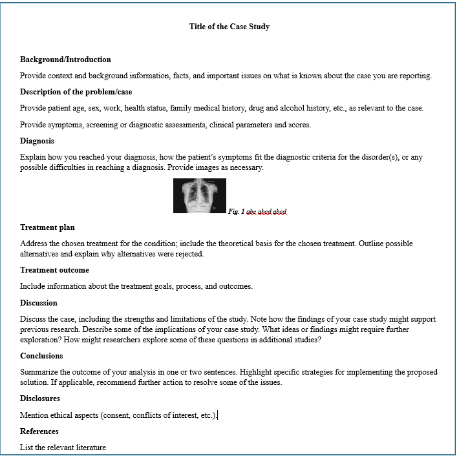
Figure 1. Case study template
Table 1. From research question to case study : Some fictional examples
Real case study examples (published):
- Baker et al. (2024) Enhanced family-based treatment for an adolescent with binge-eating disorder: A case report. Cognitive and Behavioral Practice . 31(2), 272–282.
- da Silva et al. (2024) Impacts of oil palm monocultures on freshwater ecosystems in the Amazon: a case study of dragonflies and damselflies (Insecta: Odonata). Aquatic Science 87, 1.
- Sakamoto et al. (2024) Online gaming reduces psychological distress in a patient with schizophrenia: A case report. PCN Reports. 3(3), e70015.

What Are the Benefits of a Case Study ?
On the topic of the case study , a quote by Ivy Mckenzie comes to mind: “The physician is concerned [unlike the naturalist]…with a single organism, the human subject, striving to preserve its identity in adverse circumstances .”
A physician’s meticulous documentation of an unusual or rare condition might not only help the patient but also revolutionize current understanding of the disorder and lead to a revision of treatment protocols. In fact, clinicians and psychologists are often encouraged to publish more case studies documenting the methods they use.
Let’s look at some more benefits of a case study :
- They can be published quickly.
- They are suitable under situations of time and budget crunches.
- They are appropriate to study phenomena in their natural context
- They allow detailed investigation into situations that would otherwise be impractical to perform using another study design.
- They are sometimes used in therapy to guide the best course of treatment.
What Are the Limitations of a Case Study ?
Case studies provide critical information and galvanize further research; however, there are some caveats. The following are the limitations of a case study :
- A case study is not definitive proof of a theory and cannot demonstrate cause and effect.
- Case studies with insufficient or incorrect information or based on a flawed premise can harm future research.
- Ethical issues may arise if the reported patients have not provided consent for publication of their case or are not treated with dignity and respect.
- If a patient declines to provide consent, the case report cannot be written or published.
- A case study cannot necessarily be generalized to the larger population.
- A case study might be impossible or difficult to replicate.
- Case reports can lead to bias.
Key Takeaways
- A case study in research is an in-depth or intensive study of a person, group, or event using qualitative data. It is used to examine complex phenomena through detailed analysis of specific instances. Case studies are particularly valuable in psychology, medicine, and other fields for drawing broader conclusions
- Case study methods involve data collection through direct observations, interviews, and analyses of primary and secondary sources.
- Case reports are typically 500–1,500 words long. You may develop single case studies (for unique cases) or multiple case studies (case series, for comparative analysis). Where applicable, be sure to follow specific guidelines (e.g., CARE guidelines for medical cases).
- A case study design is best used when deep understanding is needed, time and resources are limited, and the natural context must be preserved. It is suited to studying exploratory research questions, unique situations, emerging conditions, and atypical behavior.
- Writing case studies involves the following steps:
- Pre-writing phase:
– Select appropriate case based on research problem
– Conduct literature review
– Collect thorough qualitative data
– Analyze case to identify key problems
- Writing phase:
– State key problem and thesis in introduction
– Describe specific case/event
– Provide solutions and implementation strategies
– Discuss strengths and limitations
– Link findings to existing literature
- The advantages of case studies are that they permit quick writing and publication, are cost-effective, are suitable for natural context study, and are extremely valuable for rare or unusual cases. The limitations of case studies, however, are that they cannot prove cause and effect, may not be generalizable, are difficult to replicate, are prone to bias, and require patient consent in medical cases.

Frequently Asked Questions
What is a case study in research, why are case studies important in research, what are the key components of a case study, what is the difference between case studies and case series.
Paperpal is a comprehensive AI writing toolkit that helps students and researchers achieve 2x the writing in half the time. It leverages 22+ years of STM experience and insights from millions of research articles to provide in-depth academic writing, language editing, and submission readiness support to help you write better, faster.
Get accurate academic translations, rewriting support, grammar checks, vocabulary suggestions, and generative AI assistance that delivers human precision at machine speed. Try for free or upgrade to Paperpal Prime starting at US$25 a month to access premium features, including consistency, plagiarism, and 30+ submission readiness checks to help you succeed.
Experience the future of academic writing – Sign up to Paperpal and start writing for free!
Related Reads:
- PhD Qualifying Exam: Tips For Success
- Academic Editing: How to Self-Edit Academic Text With Paperpal
- How to Write the First Draft of a Research Paper with Paperpal?
How to Write an Academic Paragraph (Step-by-Step Guide)
Boost your earnings with paperpal’s newly launched affiliate program, you may also like, how to cite in apa format (7th edition):..., how to write your research paper in apa..., how to choose a dissertation topic, how to write a phd research proposal, research funding basics: what should a grant proposal..., how to write the first draft of a..., mla works cited page: format, template & examples, academic editing: how to self-edit academic text with..., measuring academic success: definition & strategies for excellence.

Student Case Study
Ai generator.
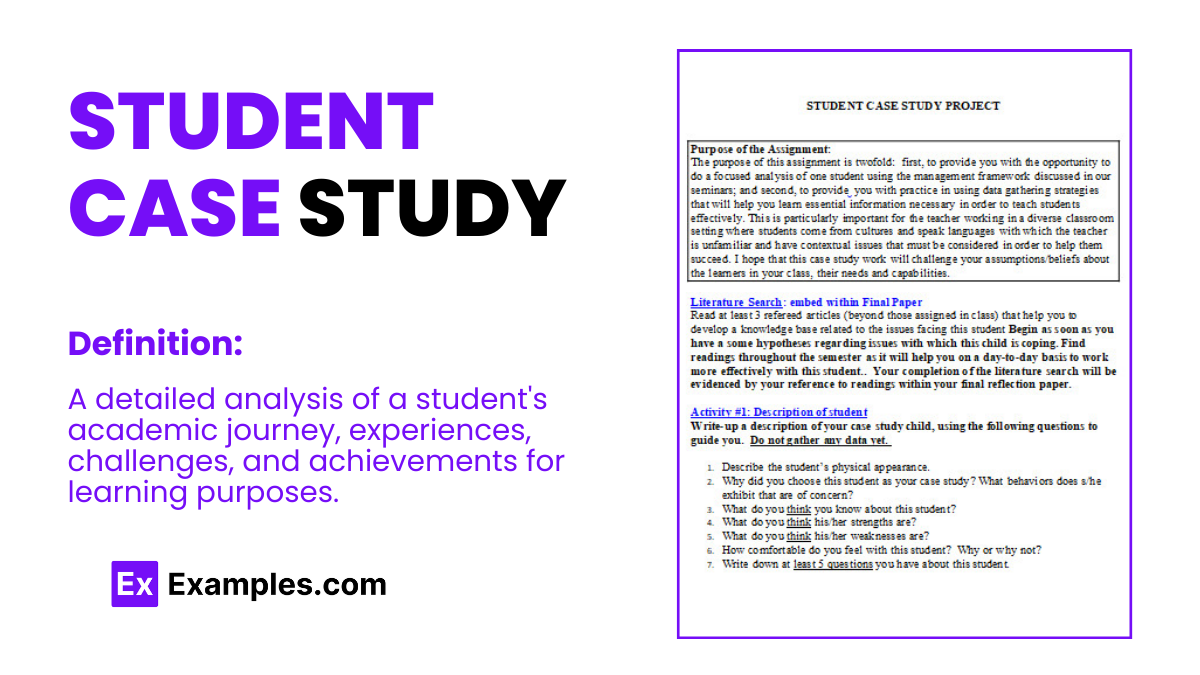
Delving into student case studies offers invaluable insights into educational methodologies and student behaviors. This guide, complete with detailed case study examples , is designed to help educators, researchers, and students understand the nuances of creating and analyzing case studies in an educational context. By exploring various case study examples, you will gain the tools and knowledge necessary to effectively interpret and apply these studies, enhancing both teaching and learning experiences in diverse academic settings.
What is a Student Case Study? – Meaning A student case study is an in-depth analysis of a student or a group of students to understand various educational, psychological, or social aspects. It involves collecting detailed information through observations, interviews, and reviewing records, to form a comprehensive picture. The goal of a case study analysis is to unravel the complexities of real-life situations that students encounter, making it a valuable tool in educational research. In a case study summary, key findings are presented, often leading to actionable insights. Educators and researchers use these studies to develop strategies for improving learning environments. Additionally, a case study essay allows students to demonstrate their understanding by discussing the analysis and implications of the case study, fostering critical thinking and analytical skills.

Download Student Case Study Bundle
Schools especially those that offers degree in medicine, law, public policy and public health teaches students to learn how to conduct a case study. Some students say they love case studies . For what reason? Case studies offer real world challenges. They help in preparing the students how to deal with their future careers. They are considered to be the vehicle for theories and concepts that enables you to be good at giving detailed discussions and even debates. Case studies are useful not just in the field of education, but also in adhering to the arising issues in business, politics and other organizations.
Student Case Study Format
Case Study Title : Clear and descriptive title reflecting the focus of the case study. Student’s Name : Name of the student the case study is about. Prepared by : Name of the person or group preparing the case study. School Name : Name of the school or educational institution. Date : Date of completion or submission.
Introduction
Background Information : Briefly describe the student’s background, including age, grade level, and relevant personal or academic history. Purpose of the Case Study : State the reason for conducting this case study, such as understanding a particular behavior, learning difficulty, or achievement.
Case Description
Situation or Challenge : Detail the specific situation, challenge, or condition that the student is facing. Observations and Evidence : Include observations from teachers, parents, or the students themselves, along with any relevant academic or behavioral records.
Problem Analysis : Analyze the situation or challenge, identifying potential causes or contributing factors. Impact on Learning : Discuss how the situation affects the student’s learning or behavior in school.
Intervention Strategies
Action Taken : Describe any interventions or strategies implemented to address the situation. This could include educational plans, counseling, or specific teaching strategies. Results of Intervention : Detail the outcome of these interventions, including any changes in the student’s behavior or academic performance.
Conclusion and Recommendations
Summary of Findings : Summarize the key insights gained from the case study. Recommendations : Offer suggestions for future actions or strategies to further support the student. This might include recommendations for teachers, parents, or the student themselves.
Best Example of Student Case Study
Overcoming Reading Challenges: A Case Study of Emily Clark, Grade 3 Prepared by: Laura Simmons, Special Education Teacher Sunset Elementary School Date: May 12, 2024 Emily Clark, an 8-year-old student in the third grade at Sunset Elementary School, has been facing significant challenges with reading and comprehension since the first grade. Known for her enthusiasm and creativity, Emily’s struggles with reading tasks have been persistent and noticeable. The primary purpose of this case study is to analyze Emily’s reading difficulties, implement targeted interventions, and assess their effectiveness. Emily exhibits difficulty in decoding words, reading fluently, and understanding text, as observed by her teachers since first grade. Her reluctance to read aloud and frustration with reading tasks have been consistently noted. Assessments indicate that her reading level is significantly below the expected standard for her grade. Parental feedback has also highlighted Emily’s struggles with reading-related homework. Analysis of Emily’s situation suggests a potential learning disability in reading, possibly dyslexia. This is evidenced by her consistent difficulty with word recognition and comprehension. These challenges have impacted not only her reading skills but also her confidence and participation in class activities, especially those involving reading. To address these challenges, an individualized education plan (IEP) was developed. This included specialized reading instruction focusing on phonemic awareness and decoding skills, multisensory learning approaches, and regular sessions with a reading specialist. Over a period of six months, Emily demonstrated significant improvements. She engaged more confidently in reading activities, and her reading assessment scores showed notable progress. In conclusion, the intervention strategies implemented for Emily have been effective. Her case highlights the importance of early identification and the implementation of tailored educational strategies for students with similar challenges. It is recommended that Emily continues to receive specialized instruction and regular monitoring. Adjustments to her IEP should be made as necessary to ensure ongoing progress. Additionally, fostering a positive reading environment at home is also recommended.
18+ Student Case Study Examples
1. student case study.
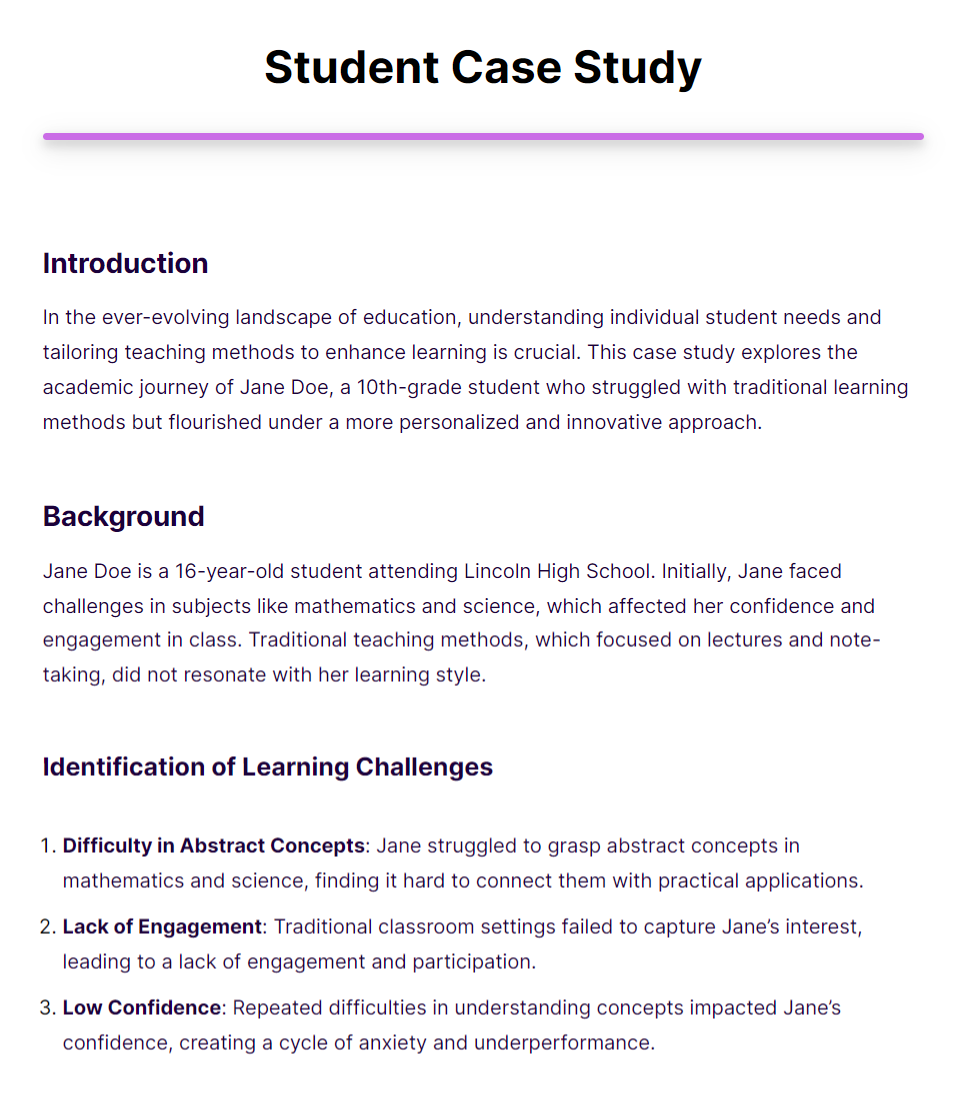
2. College Student Case Study
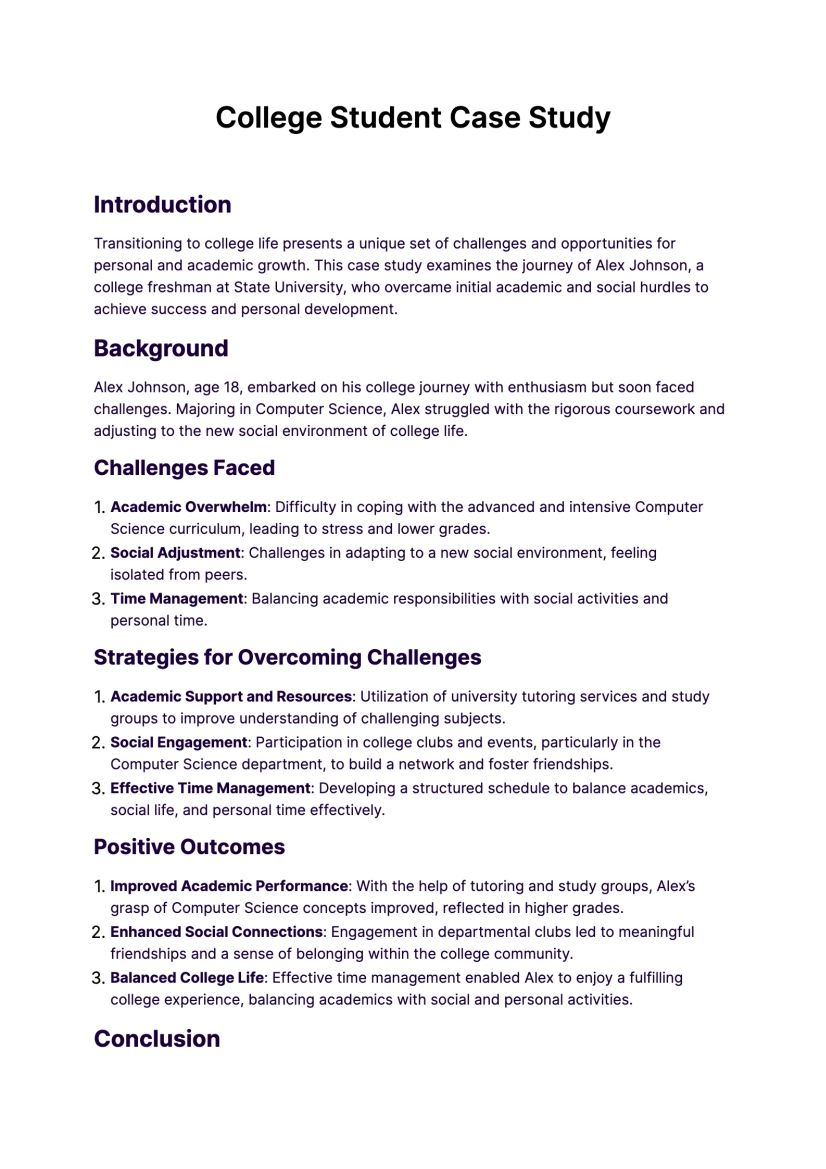
3. Student Case Study in the Classroom
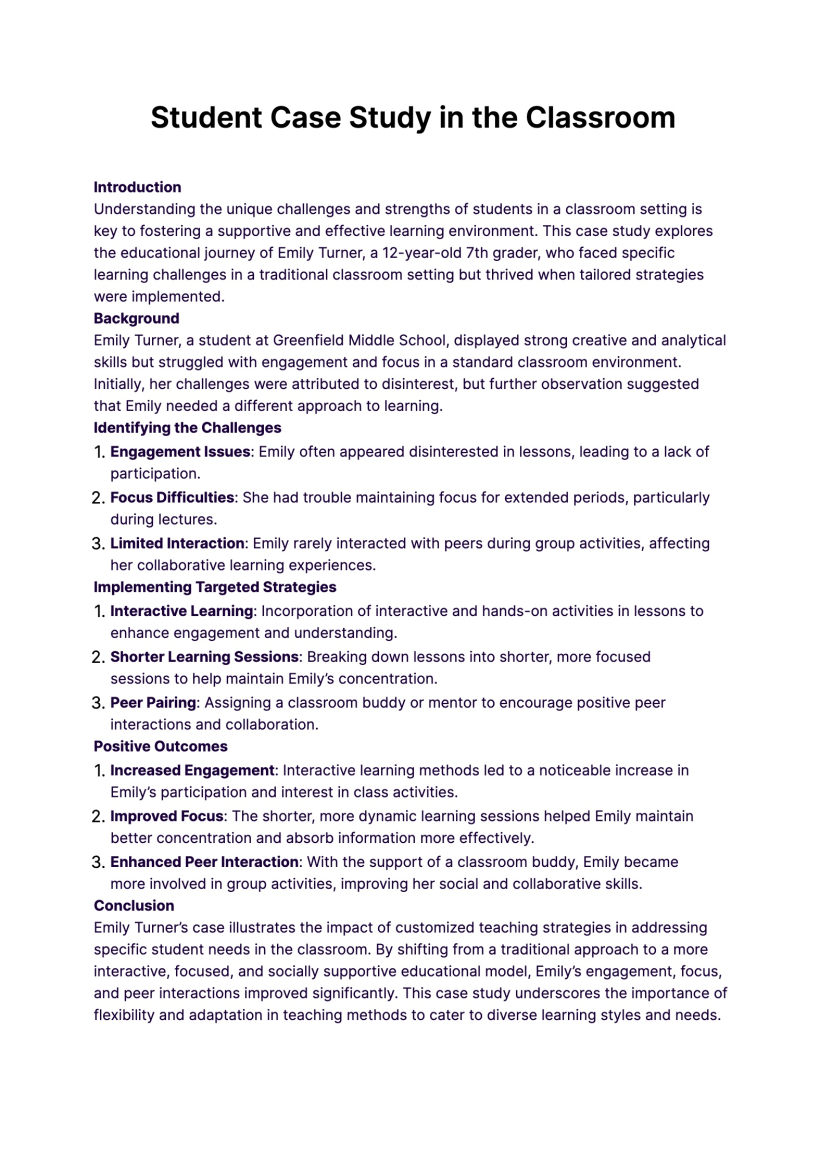
Free Download
4. Student Case Study Format Template
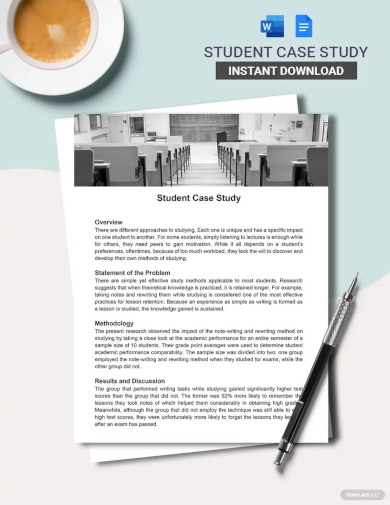
- Google Docs
Size: 153 KB
5. Sample Student Case Study Example
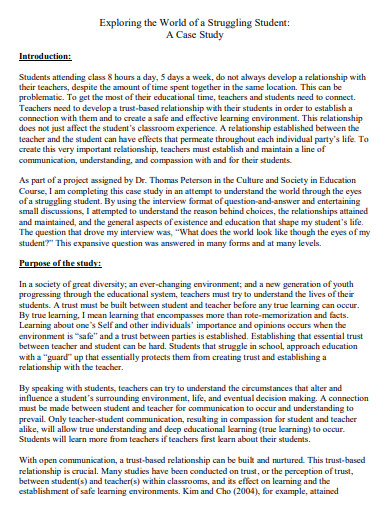
stu.westga.edu
Size: 241 KB
6. Education Case Study Examples for Students
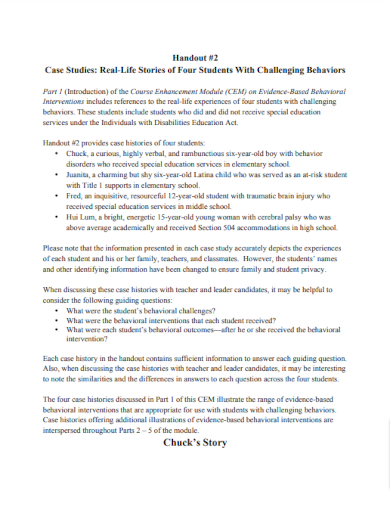
ceedar.education.ufl.edu
Size: 129 KB
7. Graduate Student Case Study Example
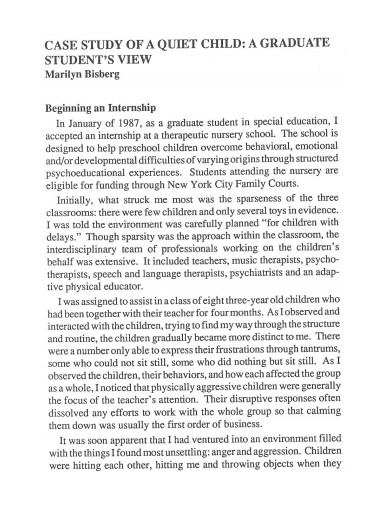
educate.bankstreet.edu
8. Student Profile Case Study Example
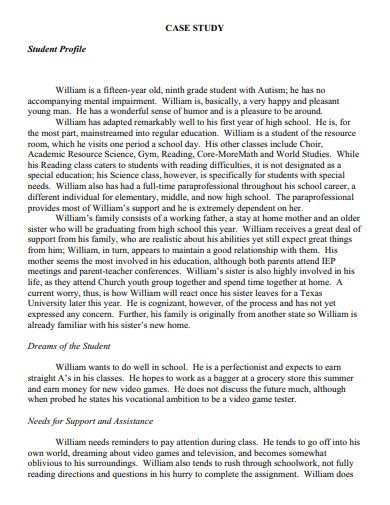
wholeschooling.net
Size: 51 KB
9. Short Student Case Study Example
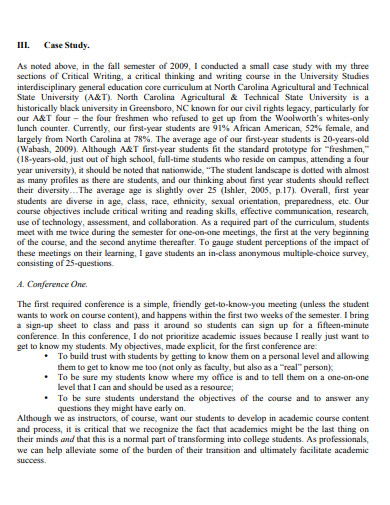
files.eric.ed.gov
Size: 192 KB
10. High School Student Case Study Example

educationforatoz.com
Size: 135 KB
11. Student Research Case Study Example
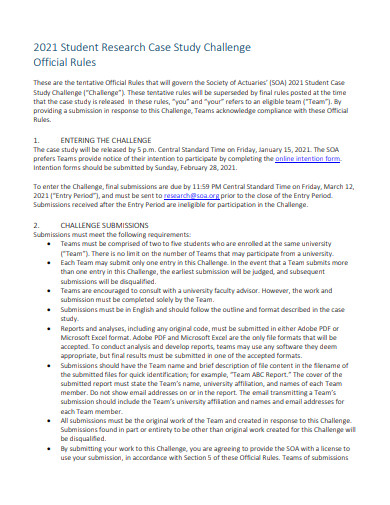
Size: 67 KB
12. Classroom Case Study Examples

Size: 149 KB
13. Case Study of a Student
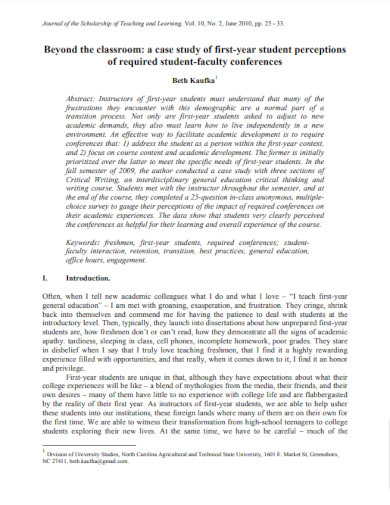
14. Sample Student Assignment Case Study Example
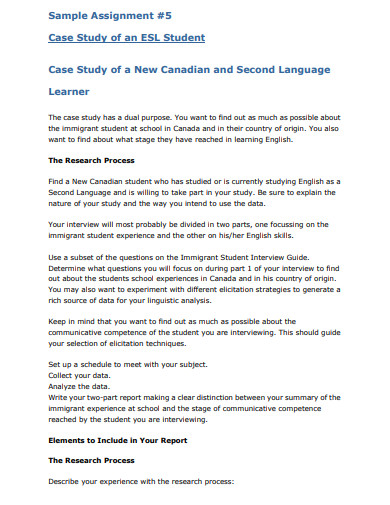
oise.utoronto.ca
Size: 43 KB
15. College Student Case Study Example
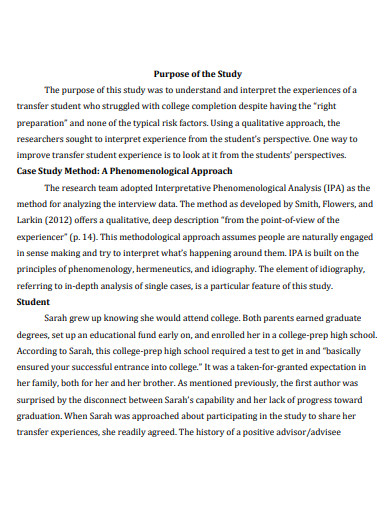
Size: 221 KB
16. Basic Student Case Study Example
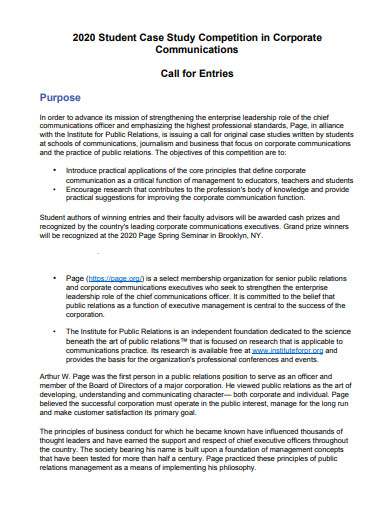
Size: 206 KB
17. Free Student Impact Case Study Example

Size: 140 KB
18. Student Case Study in DOC Example
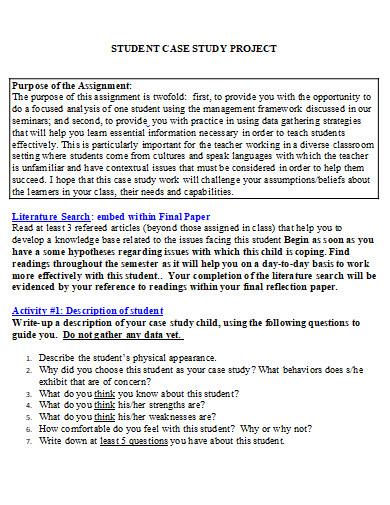
old.sjsu.edu
Size: 12 KB
19. Case Study Of a Student with Anxiety
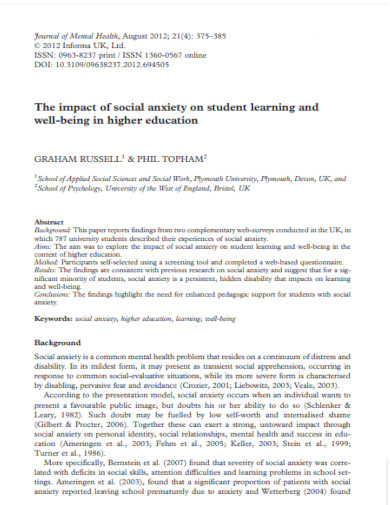
Size: 178 KB
Case Study Definition
A case study is defined as a research methodology that allows you to conduct an intensive study about a particular person, group of people, community, or some unit in which the researcher could provide an in-depth data in relation to the variables. Case studies can examine a phenomena in the natural setting. This increases your ability to understand why the subjects act such. You may be able to describe how this method allows every researcher to take a specific topic to narrow it down making it into a manageable research question. The researcher gain an in-depth understanding about the subject matter through collecting qualitative research and quantitative research datasets about the phenomenon.
Benefits and Limitations of Case Studies
If a researcher is interested to study about a phenomenon, he or she will be assigned to a single-case study that will allow him or her to gain an understanding about the phenomenon. Multiple-case study would allow a researcher to understand the case as a group through comparing them based on the embedded similarities and differences. However, the volume of data in case studies will be difficult to organize and the process of analysis and strategies needs to be carefully decided upon. Reporting of findings could also be challenging at times especially when you are ought to follow for word limits.
Example of Case Study
Nurses’ pediatric pain management practices.
One of the authors of this paper (AT) has used a case study approach to explore nurses’ pediatric pain management practices. This involved collecting several datasets:
Observational data to gain a picture about actual pain management practices.
Questionnaire data about nurses’ knowledge about pediatric pain management practices and how well they felt they managed pain in children.
Questionnaire data about how critical nurses perceived pain management tasks to be.
These datasets were analyzed separately and then compared and demonstrated that nurses’ level of theoretical did not impact on the quality of their pain management practices. Nor did individual nurse’s perceptions of how critical a task was effect the likelihood of them carrying out this task in practice. There was also a difference in self-reported and observed practices; actual (observed) practices did not confirm to best practice guidelines, whereas self-reported practices tended to.
How do you Write a Case Study for Students?
1. choose an interesting and relevant topic:.
Select a topic that is relevant to your course and interesting to your audience. It should be specific and focused, allowing for in-depth analysis.
2. Conduct Thorough Research :
Gather information from reputable sources such as books, scholarly articles, interviews, and reliable websites. Ensure you have a good understanding of the topic before proceeding.
3. Identify the Problem or Research Question:
Clearly define the problem or research question your case study aims to address. Be specific about the issues you want to explore and analyze.

4. Introduce the Case:
Provide background information about the subject, including relevant historical, social, or organizational context. Explain why the case is important and what makes it unique.
5. Describe the Methods Used:
Explain the methods you used to collect data. This could include interviews, surveys, observations, or analysis of existing documents. Justify your choice of methods.
6. Present the Findings:
Present the data and findings in a clear and organized manner. Use charts, graphs, and tables if applicable. Include direct quotes from interviews or other sources to support your points.
7. Analytical Interpretation:
Analyze the data and discuss the patterns, trends, or relationships you observed. Relate your findings back to the research question. Use relevant theories or concepts to support your analysis.
8. Discuss Limitations:
Acknowledge any limitations in your study, such as constraints in data collection or research methods. Addressing limitations shows a critical awareness of your study’s scope.
9. Propose Solutions or Recommendations:
If your case study revolves around a problem, propose practical solutions or recommendations based on your analysis. Support your suggestions with evidence from your findings.
10. Write a Conclusion:
Summarize the key points of your case study. Restate the importance of the topic and your findings. Discuss the implications of your study for the broader field.
What are the objectives of a Student Case Study?
1. learning and understanding:.
- To deepen students’ understanding of a particular concept, theory, or topic within their field of study.
- To provide real-world context and practical applications for theoretical knowledge.
2. Problem-Solving Skills:
- To enhance students’ critical thinking and problem-solving abilities by analyzing complex issues or scenarios.
- To encourage students to apply their knowledge to real-life situations and develop solutions.
3. Research and Analysis:
- To develop research skills, including data collection, data analysis , and the ability to draw meaningful conclusions from information.
- To improve analytical skills in interpreting data and making evidence-based decisions.
4. Communication Skills:
- To improve written and oral communication skills by requiring students to present their findings in a clear, organized, and coherent manner.
- To enhance the ability to communicate complex ideas effectively to both academic and non-academic audiences.
5. Ethical Considerations:
To promote awareness of ethical issues related to research and decision-making, such as participant rights, privacy, and responsible conduct.
6. Interdisciplinary Learning:
To encourage cross-disciplinary or interdisciplinary thinking, allowing students to apply knowledge from multiple areas to address a problem or issue.
7. Professional Development:
- To prepare students for future careers by exposing them to real-world situations and challenges they may encounter in their chosen profession.
- To develop professional skills, such as teamwork, time management, and project management.
8. Reflection and Self-Assessment:
- To prompt students to reflect on their learning and evaluate their strengths and weaknesses in research and analysis.
- To foster self-assessment and a commitment to ongoing improvement.
9. Promoting Innovation:
- To inspire creativity and innovation in finding solutions to complex problems or challenges.
- To encourage students to think outside the box and explore new approaches.
10. Building a Portfolio:
To provide students with tangible evidence of their academic and problem-solving abilities that can be included in their academic or professional portfolios.
What are the Elements of a Case Study?
A case study typically includes an introduction, background information, presentation of the main issue or problem, analysis, solutions or interventions, and a conclusion. It often incorporates supporting data and references.
How Long is a Case Study?
The length of a case study can vary, but it generally ranges from 500 to 1500 words. This length allows for a detailed examination of the subject while maintaining conciseness and focus.
How Big Should a Case Study Be?
The size of a case study should be sufficient to comprehensively cover the topic, typically around 2 to 5 pages. This size allows for depth in analysis while remaining concise and readable.
What Makes a Good Case Study?
A good case study is clear, concise, and well-structured, focusing on a relevant and interesting issue. It should offer insightful analysis, practical solutions, and demonstrate real-world applications or implications.
Case studies bring people into the real world to allow themselves engage in different fields such as in business examples, politics, health related aspect where each individuals could find an avenue to make difficult decisions. It serves to provide framework for analysis and evaluation of the different societal issues. This is one of the best way to focus on what really matters, to discuss about issues and to know what can we do about it.
Text prompt
- Instructive
- Professional
Education Case Study Examples for Students
Graduate Student Case Study Example
Student Profile Case Study Example
High School Student Case Study Example
Student Research Case Study Example

Case Studies
What are case studies.
Case studies are an innovative pedagogical tool involving stories or scenarios, often in narrative form, created and used for in-depth analysis and discussion of real-world situations to consolidate learning of concepts and principles. Case studies help students apply theoretical knowledge to practical scenarios, fostering critical thinking and problem-solving skills by encouraging the evaluation of complex issues. They have long been used in higher education, particularly in business and law.
Typically implemented through classroom discussions, written analyses, and presentations, case studies enhance student engagement by connecting learning to real-world application. Additionally, case studies promote the development of essential skills like teamwork, communication, and strategic thinking.
The Harvard Business School has been using the case study method for over 100 years with a range of noted benefits.
Why use case studies?
Case studies actively engage students in the learning process by placing them in a scenario that requires higher order thinking and application of new knowledge and concepts.
Rather than just passively consuming learning material, like a traditional teacher-centred lecture, case studies allow for the educator to guide students through scenarios and set parameters to ensure students gain graduate ready skills and crucial critical thinking skills.
Case studies benefit students in the following ways:
- Encourages critical reflection and research
- Develops students' critical thinking skills
- Promotes higher-order thinking (such as in the top levels of Bloom’s Taxonomy)
- Creates a safe space for students to apply previously acquired skills and learn from each other
- Enables students to develop solutions to real-life, complex situations through problem solving
Types of case studies
There are a range of types of case studies you could use in your teaching and in research, however the two most common in higher education are:
- Descriptive case studies – explores a specific event or issue to identify key facts, what happened and who was involved. Typically this type of case study does not include a solution but rather prompts students to gain a greater understanding of multiple perspectives.
- Problem-solving case studies – prompts students to critically examine an issue, research and recommend solutions by integrating theory and practice.
Teaching with case studies
Case studies that are used in your teaching should be clearly linked to course learning outcomes, other teaching strategies and assessments. To ensure that the case study is effective it is important to set up clear expectations for student behaviour and engagement with the learning activity. This is especially important if this is the first time you are integrating a case study into your student learning activities.
How to create case studies
Once you have decided on what type of case study you would like to implement in your classroom, it’s now time to create your case study. Depending on your context, your case study could include general knowledge or adopt the perspective of a protagonist (client, patient, student, organisation, business etc.) or information from government, company or other public documents.
A case study should:
- Begin with an introduction that clearly establishes the scene and the problem/protagonist;
- Escalate the narrative with further complications to the problem;
- Finally the situation should come to a head.
When writing a case study, ensure that all information provided is clear, concise and connected to the case study. You could use AI to help draft the first version of your case study before you edit and ensure that it is fit for purpose in your area, or use it to design an interactive, ongoing scenario.
Further resources:
Write a teaching case study - Emerald Group Publishing
Case studies - Teaching UNSW
The University of Newcastle acknowledges the traditional custodians of the lands within our footprint areas: Awabakal, Darkinjung, Biripai, Worimi, Wonnarua, and Eora Nations. We also pay respect to the wisdom of our Elders past and present.
Are you visiting our site from South Asia ? Head to our dedicated page with all the information you need to study at the University of Newcastle. Close
您是否在中国访问我们的网址? 前往 专属页面 ,查询你在纽卡斯尔大学学习所需的所有信息。 Close
- College Essay
- Argumentative Essay
- Expository Essay
- Narrative Essay
- Descriptive Essay
- Scholarship Essay
- Admission Essay
- Reflective Essay
- Nursing Essay
- Economics Essay
Assignments
- Term Papers
- Research Papers
- Case Studies
- Dissertation
- Presentation
- Editing Help
- Cheap Essay Writing
- How to Order
Writing A Case Study
Case Study Examples
Brilliant Case Study Examples and Templates For Your Help
15 min read
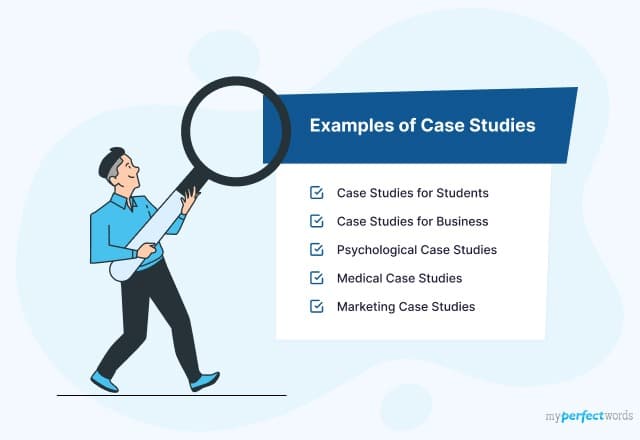
People also read
A Complete Case Study Writing Guide With Examples
Simple Case Study Format for Students to Follow
Understand the Types of Case Study Here
It’s no surprise that writing a case study is one of the most challenging academic tasks for students. You’re definitely not alone here!
Most people don't realize that there are specific guidelines to follow when writing a case study. If you don't know where to start, it's easy to get overwhelmed and give up before you even begin.
Don't worry! Let us help you out!
We've collected over 25 free case study examples with solutions just for you. These samples with solutions will help you win over your panel and score high marks on your case studies.
So, what are you waiting for? Let's dive in and learn the secrets to writing a successful case study.
- 1. An Overview of Case Studies
- 2. Case Study Examples for Students
- 3. Business Case Study Examples
- 4. Medical Case Study Examples
- 5. Psychology Case Study Examples
- 6. Sales Case Study Examples
- 7. Interview Case Study Examples
- 8. Marketing Case Study Examples
- 9. Tips to Write a Good Case Study
An Overview of Case Studies
A case study is a research method used to study a particular individual, group, or situation in depth. It involves analyzing and interpreting data from a variety of sources to gain insight into the subject being studied.
Case studies are often used in psychology, business, and education to explore complicated problems and find solutions. They usually have detailed descriptions of the subject, background info, and an analysis of the main issues.
The goal of a case study is to provide a comprehensive understanding of the subject. Typically, case studies can be divided into three parts, challenges, solutions, and results.
Here is a case study sample PDF so you can have a clearer understanding of what a case study actually is:
Case Study Sample PDF
How to Write a Case Study Examples
Learn how to write a case study with the help of our comprehensive case study guide.
Case Study Examples for Students
Quite often, students are asked to present case studies in their academic journeys. The reason instructors assign case studies is for students to sharpen their critical analysis skills, understand how companies make profits, etc.
Below are some case study examples in research, suitable for students:
Case Study Example in Software Engineering
Qualitative Research Case Study Sample
Software Quality Assurance Case Study
Social Work Case Study Example
Ethical Case Study
Case Study Example PDF
These examples can guide you on how to structure and format your own case studies.
Struggling with formatting your case study? Check this case study format guide and perfect your document’s structure today.
Business Case Study Examples
A business case study examines a business’s specific challenge or goal and how it should be solved. Business case studies usually focus on several details related to the initial challenge and proposed solution.
To help you out, here are some samples so you can create case studies that are related to businesses:
Here are some more business case study examples:
Business Case Studies PDF
Business Case Studies Example
Typically, a business case study discovers one of your customer's stories and how you solved a problem for them. It allows your prospects to see how your solutions address their needs.
Medical Case Study Examples
Medical case studies are an essential part of medical education. They help students to understand how to diagnose and treat patients.
Here are some medical case study examples to help you.
Medical Case Study Example
Nursing Case Study Example
Want to understand the various types of case studies? Check out our types of case study blog to select the perfect type.
Psychology Case Study Examples
Case studies are a great way of investigating individuals with psychological abnormalities. This is why it is a very common assignment in psychology courses.
By examining all the aspects of your subject’s life, you discover the possible causes of exhibiting such behavior.
For your help, here are some interesting psychology case study examples:
Psychology Case Study Example
Mental Health Case Study Example
Sales Case Study Examples
Case studies are important tools for sales teams’ performance improvement. By examining sales successes, teams can gain insights into effective strategies and create action plans to employ similar tactics.
By researching case studies of successful sales campaigns, sales teams can more accurately identify challenges and develop solutions.
Sales Case Study Example
Interview Case Study Examples
Interview case studies provide businesses with invaluable information. This data allows them to make informed decisions related to certain markets or subjects.
Interview Case Study Example
Marketing Case Study Examples
Marketing case studies are real-life stories that showcase how a business solves a problem. They typically discuss how a business achieves a goal using a specific marketing strategy or tactic.
They typically describe a challenge faced by a business, the solution implemented, and the results achieved.
This is a short sample marketing case study for you to get an idea of what an actual marketing case study looks like.
Here are some more popular marketing studies that show how companies use case studies as a means of marketing and promotion:
“Chevrolet Discover the Unexpected” by Carol H. Williams
This case study explores Chevrolet's “ DTU Journalism Fellows ” program. The case study uses the initials “DTU” to generate interest and encourage readers to learn more.
Multiple types of media, such as images and videos, are used to explain the challenges faced. The case study concludes with an overview of the achievements that were met.
Key points from the case study include:
- Using a well-known brand name in the title can create interest.
- Combining different media types, such as headings, images, and videos, can help engage readers and make the content more memorable.
- Providing a summary of the key achievements at the end of the case study can help readers better understand the project's impact.
“The Met” by Fantasy
“ The Met ” by Fantasy is a fictional redesign of the Metropolitan Museum of Art in New York City, created by the design studio Fantasy. The case study clearly and simply showcases the museum's website redesign.
The Met emphasizes the website’s features and interface by showcasing each section of the interface individually, allowing the readers to concentrate on the significant elements.
For those who prefer text, each feature includes an objective description. The case study also includes a “Contact Us” call-to-action at the bottom of the page, inviting visitors to contact the company.
Key points from this “The Met” include:
- Keeping the case study simple and clean can help readers focus on the most important aspects.
- Presenting the features and solutions with a visual showcase can be more effective than writing a lot of text.
- Including a clear call-to-action at the end of the case study can encourage visitors to contact the company for more information.
“Better Experiences for All” by Herman Miller
Herman Miller's minimalist approach to furniture design translates to their case study, “ Better Experiences for All ”, for a Dubai hospital. The page features a captivating video with closed-captioning and expandable text for accessibility.
The case study presents a wealth of information in a concise format, enabling users to grasp the complexities of the strategy with ease. It concludes with a client testimonial and a list of furniture items purchased from the brand.
Key points from the “Better Experiences” include:
- Make sure your case study is user-friendly by including accessibility features like closed captioning and expandable text.
- Include a list of products that were used in the project to guide potential customers.
“NetApp” by Evisort
Evisort's case study on “ NetApp ” stands out for its informative and compelling approach. The study begins with a client-centric overview of NetApp, strategically directing attention to the client rather than the company or team involved.
The case study incorporates client quotes and explores NetApp’s challenges during COVID-19. Evisort showcases its value as a client partner by showing how its services supported NetApp through difficult times.
- Provide an overview of the company in the client’s words, and put focus on the customer.
- Highlight how your services can help clients during challenging times.
- Make your case study accessible by providing it in various formats.
“Red Sox Season Campaign,” by CTP Boston
The “ Red Sox Season Campaign ” showcases a perfect blend of different media, such as video, text, and images. Upon visiting the page, the video plays automatically, there are videos of Red Sox players, their images, and print ads that can be enlarged with a click.
The page features an intuitive design and invites viewers to appreciate CTP's well-rounded campaign for Boston's beloved baseball team. There’s also a CTA that prompts viewers to learn how CTP can create a similar campaign for their brand.
Some key points to take away from the “Red Sox Season Campaign”:
- Including a variety of media such as video, images, and text can make your case study more engaging and compelling.
- Include a call-to-action at the end of your study that encourages viewers to take the next step towards becoming a customer or prospect.
“Airbnb + Zendesk” by Zendesk
The case study by Zendesk, titled “ Airbnb + Zendesk : Building a powerful solution together,” showcases a true partnership between Airbnb and Zendesk.
The article begins with an intriguing opening statement, “Halfway around the globe is a place to stay with your name on it. At least for a weekend,” and uses stunning images of beautiful Airbnb locations to captivate readers.
Instead of solely highlighting Zendesk's product, the case study is crafted to tell a good story and highlight Airbnb's service in detail. This strategy makes the case study more authentic and relatable.
Some key points to take away from this case study are:
- Use client's offerings' images rather than just screenshots of your own product or service.
- To begin the case study, it is recommended to include a distinct CTA. For instance, Zendesk presents two alternatives, namely to initiate a trial or seek a solution.
“Influencer Marketing” by Trend and WarbyParker
The case study "Influencer Marketing" by Trend and Warby Parker highlights the potential of influencer content marketing, even when working with a limited budget.
The “Wearing Warby” campaign involved influencers wearing Warby Parker glasses during their daily activities, providing a glimpse of the brand's products in use.
This strategy enhanced the brand's relatability with influencers' followers. While not detailing specific tactics, the case study effectively illustrates the impact of third-person case studies in showcasing campaign results.
Key points to take away from this case study are:
- Influencer marketing can be effective even with a limited budget.
- Showcasing products being used in everyday life can make a brand more approachable and relatable.
- Third-person case studies can be useful in highlighting the success of a campaign.
Marketing Case Study Template
Marketing Case Study Example
Now that you have read multiple case study examples, hop on to our tips.
Tips to Write a Good Case Study
Here are some note-worthy tips to craft a winning case study
- Define the purpose of the case study This will help you to focus on the most important aspects of the case. The case study objective helps to ensure that your finished product is concise and to the point.
- Choose a real-life example. One of the best ways to write a successful case study is to choose a real-life example. This will give your readers a chance to see how the concepts apply in a real-world setting.
- Keep it brief. This means that you should only include information that is directly relevant to your topic and avoid adding unnecessary details.
- Use strong evidence. To make your case study convincing, you will need to use strong evidence. This can include statistics, data from research studies, or quotes from experts in the field.
- Edit and proofread your work. Before you submit your case study, be sure to edit and proofread your work carefully. This will help to ensure that there are no errors and that your paper is clear and concise.
There you go!
We’re sure that now you have secrets to writing a great case study at your fingertips! This blog teaches the key guidelines of various case studies with samples. So grab your pen and start crafting a winning case study right away!
Having said that, we do understand that some of you might be having a hard time writing compelling case studies.
But worry not! Our expert case study writing service is here to take all your case-writing blues away!
With 100% thorough research guaranteed, we can craft an amazing case study within 24 hours!
Besides, if you're pressed for time, simply uttering the words just do my essay for me will get your essay done quickly and flawlessly!
So why delay? Let us help you shine in the eyes of your instructor!

Write Essay Within 60 Seconds!

Dr. Barbara is a highly experienced writer and author who holds a Ph.D. degree in public health from an Ivy League school. She has worked in the medical field for many years, conducting extensive research on various health topics. Her writing has been featured in several top-tier publications.
Struggling With Your Paper?
Get a custom paper written at
With a FREE Turnitin report, and a 100% money-back guarantee
LIMITED TIME ONLY!
Keep reading
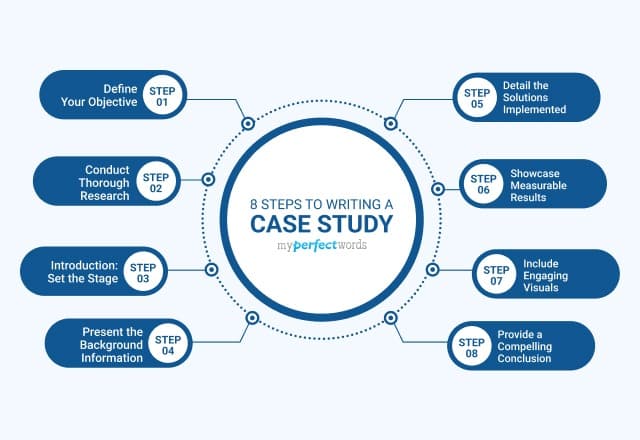
OFFER EXPIRES SOON!

IMAGES
VIDEO
COMMENTS
State the key problem and present a concise thesis under an “Introduction” or “Background” section. Provide background, facts, and evidence of research. Describe the specific case, group, or event. 3. Provide specific …
A student case study is an in-depth analysis of a student or a group of students to understand various educational, psychological, or social aspects. It involves collecting detailed information through observations, …
The purpose of case study research is twofold: (1) to provide descriptive information and (2) to suggest theoretical relevance. Rich description enables an in-depth or sharpened understanding of the case. It is unique given …
Typically this type of case study does not include a solution but rather prompts students to gain a greater understanding of multiple perspectives. Problem-solving case studies – prompts …
Discover competitive case study topics based on different subjects. Excellent case study ideas for every academic field in 2022.
Steps to Writing an Effective Case Study. Writing an effective case study requires a combination of research, analysis, and clear communication. Here are the key steps to follow when developing your case …
Learn how to write winning case studies with our guide. From examples to practical tips, our blog provides everything students need to impress professors.